The Desert Castles Of Jordan: Hidden Treasures Of The Arabian Sands

Scattered across Jordan’s eastern desert, a collection of mysterious castles stands as silent witnesses to a bygone era. These ancient structures, built during the Umayyad Caliphate (661-750 CE), served as hunting lodges, trading posts, and luxurious retreats for caliphs escaping busy city life.
From intricate frescoes to stunning architecture, these desert castles offer visitors a glimpse into the rich history and artistic achievements of early Islamic civilization.
1. Qasr Amra: The Bathing Beauty

Tucked away in Jordan’s eastern desert, this UNESCO World Heritage site dazzles visitors with its remarkably preserved frescoes. Built in the early 8th century as a royal retreat, Qasr Amra’s walls display hunting scenes, zodiac symbols, and surprisingly, nude female figures – quite unexpected in Islamic art!
The castle functioned primarily as a bathhouse, featuring an innovative hydraulic system that brought water from nearby wells. Its main hall and dome still showcase the astronomical ceiling depicting constellations and zodiac signs.
What makes Qasr Amra truly special is how it blends Byzantine, Persian and Arabic artistic influences, creating a cultural snapshot of a transitional period in Islamic history.
2. Qasr Kharana: The Mysterious Fortress

Rising dramatically from the desert floor, Qasr Kharana’s imposing stone walls and distinctive architecture have puzzled historians for centuries. Despite its fortress-like appearance with thick walls and narrow windows, many experts believe it wasn’t built for defense at all – there are no water sources nearby!
Constructed around 710 CE, the two-story structure features 60 rooms arranged around a central courtyard. Inside, you’ll find decorated plasterwork and distinctive keyhole-shaped doors that hint at Persian influences.
Theories about its purpose range from a caravanserai (traveler’s inn) to a meeting place for Bedouin tribes and Damascus officials. Its excellent preservation makes it one of Jordan’s most photogenic desert castles.
3. Qasr Al-Azraq: Lawrence’s Desert Headquarters
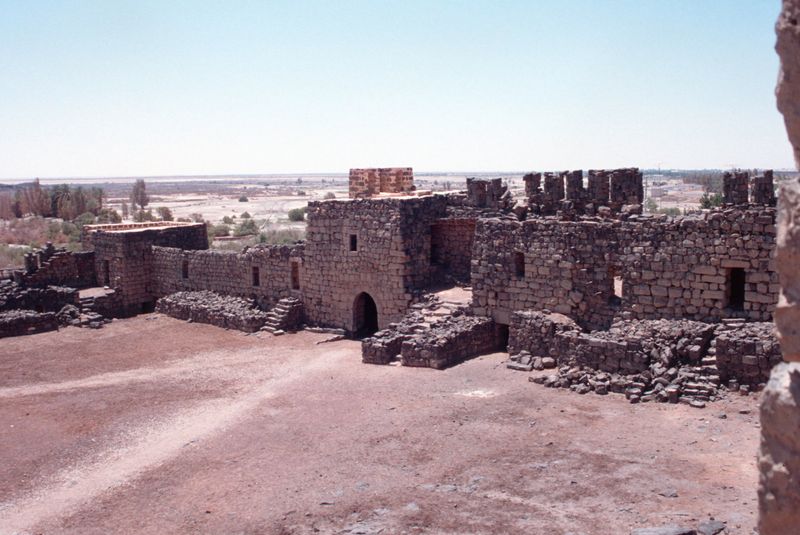
Made famous by T.E. Lawrence (Lawrence of Arabia), who used it as his winter headquarters during the Arab Revolt against the Ottoman Empire in 1917-18, Qasr Al-Azraq stands as one of the most historically significant desert castles. The black basalt fortress dates back to the 13th century, though Romans and Byzantines had structures on this site much earlier.
Unlike other desert castles, Qasr Al-Azraq remained in active use through multiple eras. Its strategic location near a precious oasis made it valuable to whoever controlled the region.
The massive entry door, weighing several tons and made from a single slab of rock, still swings on its original stone hinges – an engineering marvel that has survived centuries.
4. Qasr Al-Hallabat: The Transformed Outpost
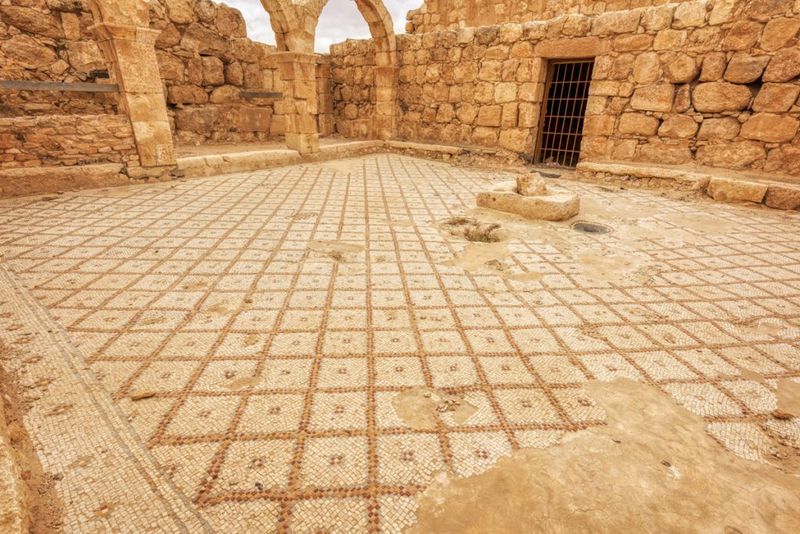
Originally a Roman fort built during Emperor Caracalla’s reign, Qasr Al-Hallabat underwent a fascinating transformation when the Umayyads converted it into a desert palace in the 8th century. The complex includes a mosque, water reservoir, and agricultural estate – showing how these castles weren’t just isolated buildings but complete settlements.
Archaeologists have uncovered stunning mosaics here featuring geometric patterns and floral designs that showcase the artistic skill of the era. Many of these treasures are now preserved in Amman’s museums.
If you look closely at the stonework, you can spot Greek inscriptions from its Roman days alongside later Arabic additions – physical evidence of the site’s multicultural history spanning centuries.
5. Qasr Al-Mushatta: The Unfinished Masterpiece
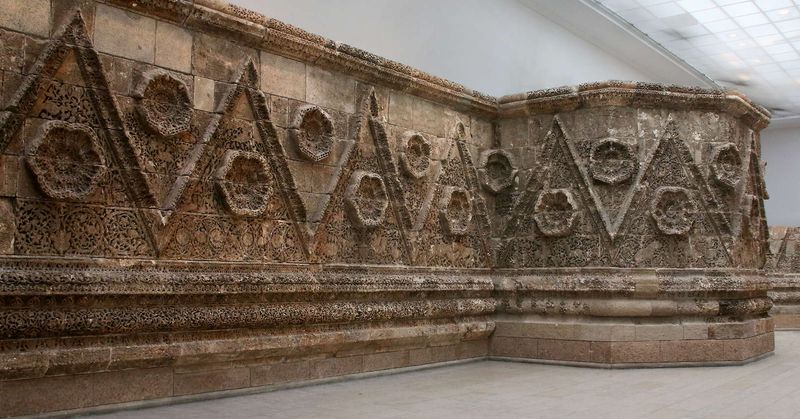
Ambition outpaced reality at Qasr Al-Mushatta, the largest and most elaborate of Jordan’s desert castles that was never completed. Construction began under Caliph Walid II around 743-744 CE but halted after his assassination, leaving behind a tantalizing glimpse of what might have been.
The palace’s most famous feature – its intricately carved facade combining Persian, Byzantine and Syrian styles – now resides in Berlin’s Pergamon Museum. German archaeologists removed it in the early 20th century as a gift from the Ottoman Sultan.
Had it been completed, this massive square complex with corner towers would have covered over 60,000 square meters, making it one of the ancient world’s most impressive palaces. Today, only its foundations and some walls remain.
6. Qasr Al-Tuba: The Remote Twin
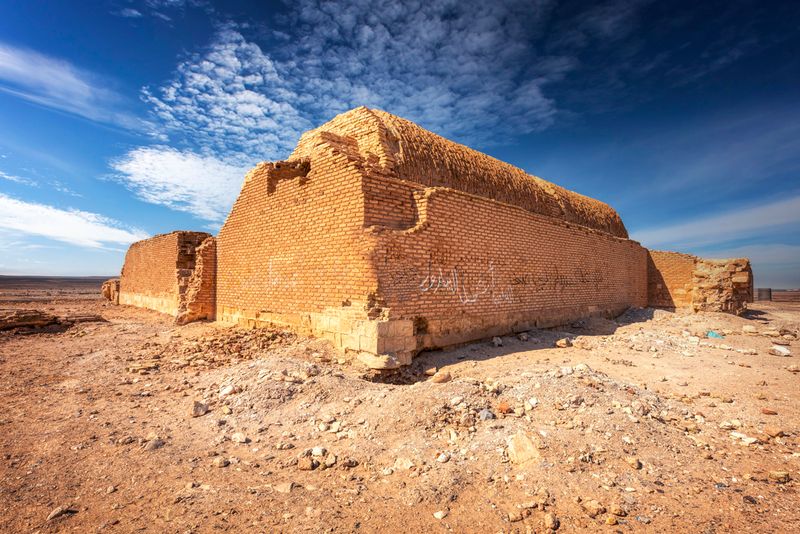
Few travelers make the journey to Qasr Al-Tuba, the most remote of Jordan’s desert castles, located deep in the eastern desert near the Saudi Arabian border. This isolation has helped preserve its unique twin-palace design – two identical rectangular structures connected by a central wall.
Built during the final years of Umayyad rule (around 743-744 CE), the castle features mud-brick construction rather than the stone used in other desert palaces. This different building technique creates a warm, earthy aesthetic that blends harmoniously with the surrounding landscape.
Despite its remoteness, archaeologists have found evidence of sophisticated water collection systems and decorative brick patterns that demonstrate the builders’ ingenuity in creating luxury in such a harsh environment.
7. Qusayr Amra: The Painted Jewel Box
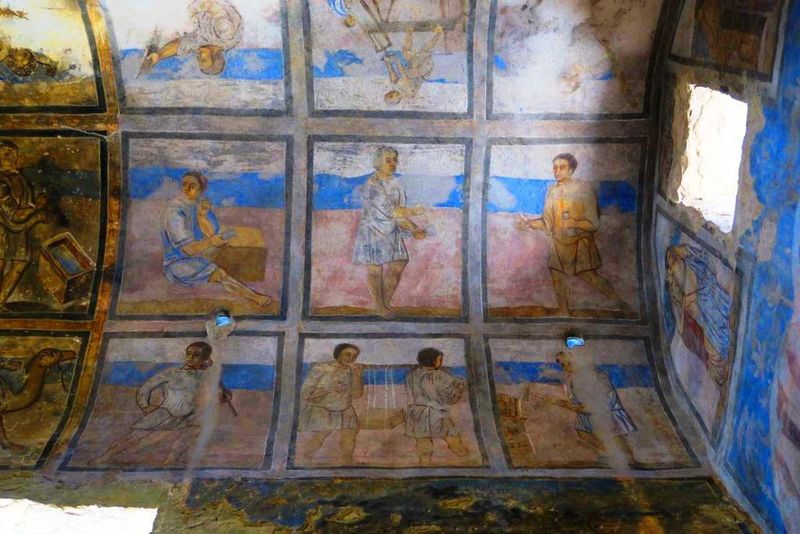
Often confused with the larger Qasr Amra, this intimate “little palace” packs an artistic punch that belies its modest size. Every inch of the interior walls and ceilings is covered with vibrant frescoes depicting hunting scenes, dancing girls, and even political figures of the day – a visual time capsule of 8th-century life.
The bath complex includes changing rooms, a tepid room, and a hot room with underfloor heating – luxuries that must have seemed miraculous in the desert. Above the bathing area, a domed ceiling depicts an accurate map of the northern hemisphere’s night sky.
Historians believe this was the private retreat of Caliph Walid I, who used it for entertainment away from religious scrutiny. Its intimate scale offers visitors a more personal connection to those who once relaxed within its painted walls.
